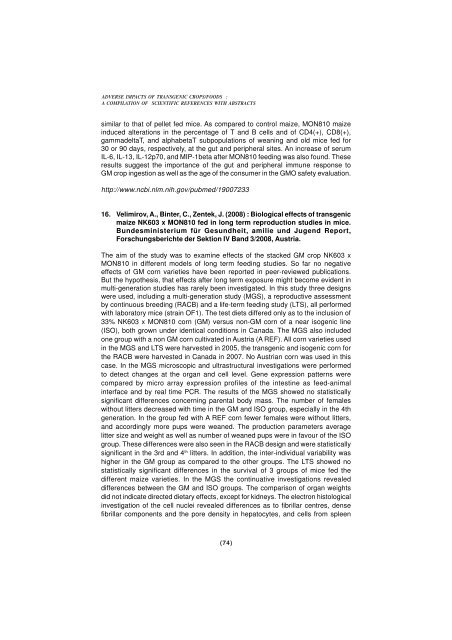omb3dyw
omb3dyw
omb3dyw
Create successful ePaper yourself
Turn your PDF publications into a flip-book with our unique Google optimized e-Paper software.
ADVERSE IMPACTS OF TRANSGENIC CROPS/FOODS :A COMPILATION OF SCIENTIFIC REFERENCES WITH ABSTRACTSsimilar to that of pellet fed mice. As compared to control maize, MON810 maizeinduced alterations in the percentage of T and B cells and of CD4(+), CD8(+),gammadeltaT, and alphabetaT subpopulations of weaning and old mice fed for30 or 90 days, respectively, at the gut and peripheral sites. An increase of serumIL-6, IL-13, IL-12p70, and MIP-1beta after MON810 feeding was also found. Theseresults suggest the importance of the gut and peripheral immune response toGM crop ingestion as well as the age of the consumer in the GMO safety evaluation.http://www.ncbi.nlm.nih.gov/pubmed/1900723316. Velimirov, A., Binter, C., Zentek, J. (2008) : Biological effects of transgenicmaize NK603 x MON810 fed in long term reproduction studies in mice.Bundesministerium für Gesundheit, amilie und Jugend Report,Forschungsberichte der Sektion IV Band 3/2008, Austria.The aim of the study was to examine effects of the stacked GM crop NK603 xMON810 in different models of long term feeding studies. So far no negativeeffects of GM corn varieties have been reported in peer-reviewed publications.But the hypothesis, that effects after long term exposure might become evident inmulti-generation studies has rarely been investigated. In this study three designswere used, including a multi-generation study (MGS), a reproductive assessmentby continuous breeding (RACB) and a life-term feeding study (LTS), all performedwith laboratory mice (strain OF1). The test diets differed only as to the inclusion of33% NK603 x MON810 corn (GM) versus non-GM corn of a near isogenic line(ISO), both grown under identical conditions in Canada. The MGS also includedone group with a non GM corn cultivated in Austria (A REF). All corn varieties usedin the MGS and LTS were harvested in 2005, the transgenic and isogenic corn forthe RACB were harvested in Canada in 2007. No Austrian corn was used in thiscase. In the MGS microscopic and ultrastructural investigations were performedto detect changes at the organ and cell level. Gene expression patterns werecompared by micro array expression profiles of the intestine as feed-animalinterface and by real time PCR. The results of the MGS showed no statisticallysignificant differences concerning parental body mass. The number of femaleswithout litters decreased with time in the GM and ISO group, especially in the 4thgeneration. In the group fed with A REF corn fewer females were without litters,and accordingly more pups were weaned. The production parameters averagelitter size and weight as well as number of weaned pups were in favour of the ISOgroup. These differences were also seen in the RACB design and were statisticallysignificant in the 3rd and 4 th litters. In addition, the inter-individual variability washigher in the GM group as compared to the other groups. The LTS showed nostatistically significant differences in the survival of 3 groups of mice fed thedifferent maize varieties. In the MGS the continuative investigations revealeddifferences between the GM and ISO groups. The comparison of organ weightsdid not indicate directed dietary effects, except for kidneys. The electron histologicalinvestigation of the cell nuclei revealed differences as to fibrillar centres, densefibrillar components and the pore density in hepatocytes, and cells from spleen(74)


